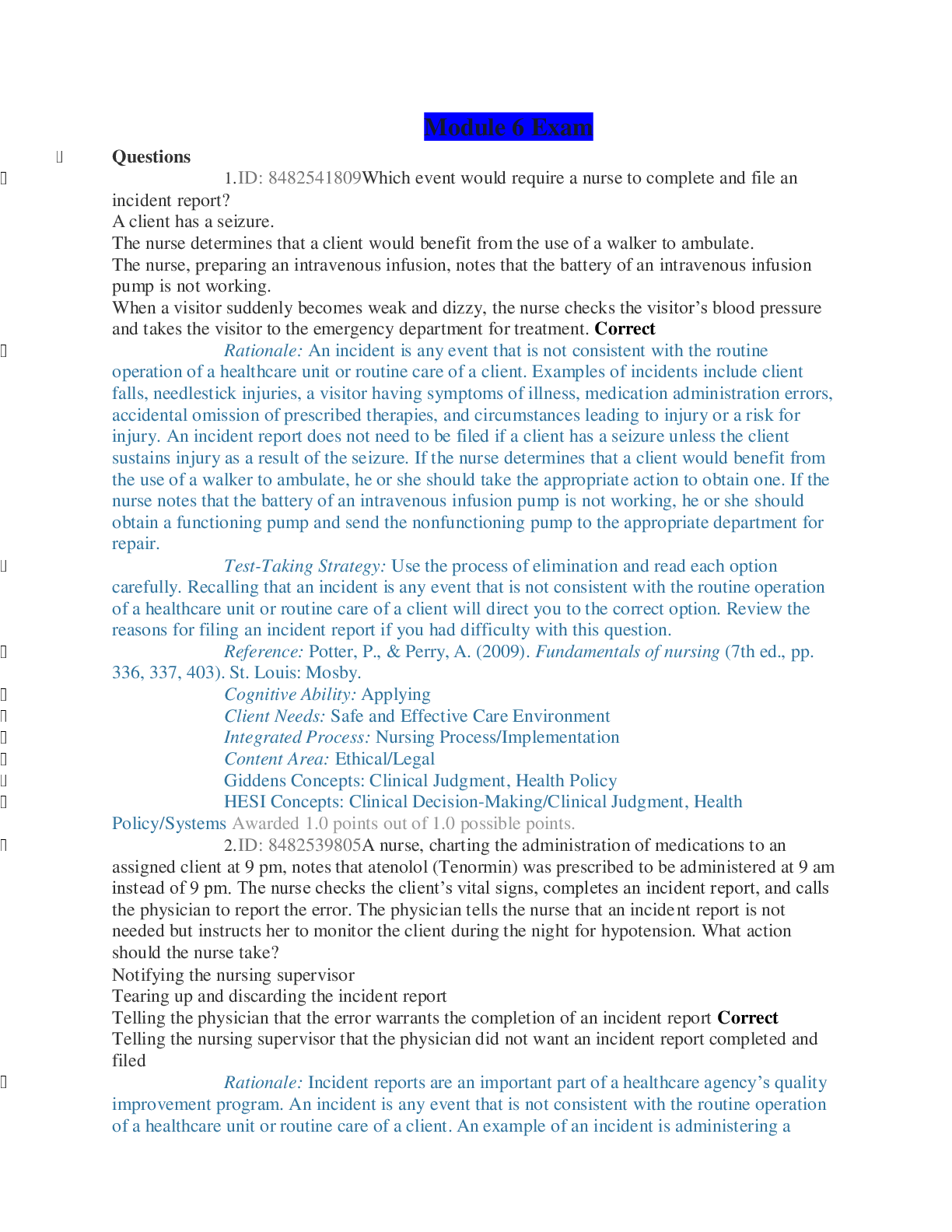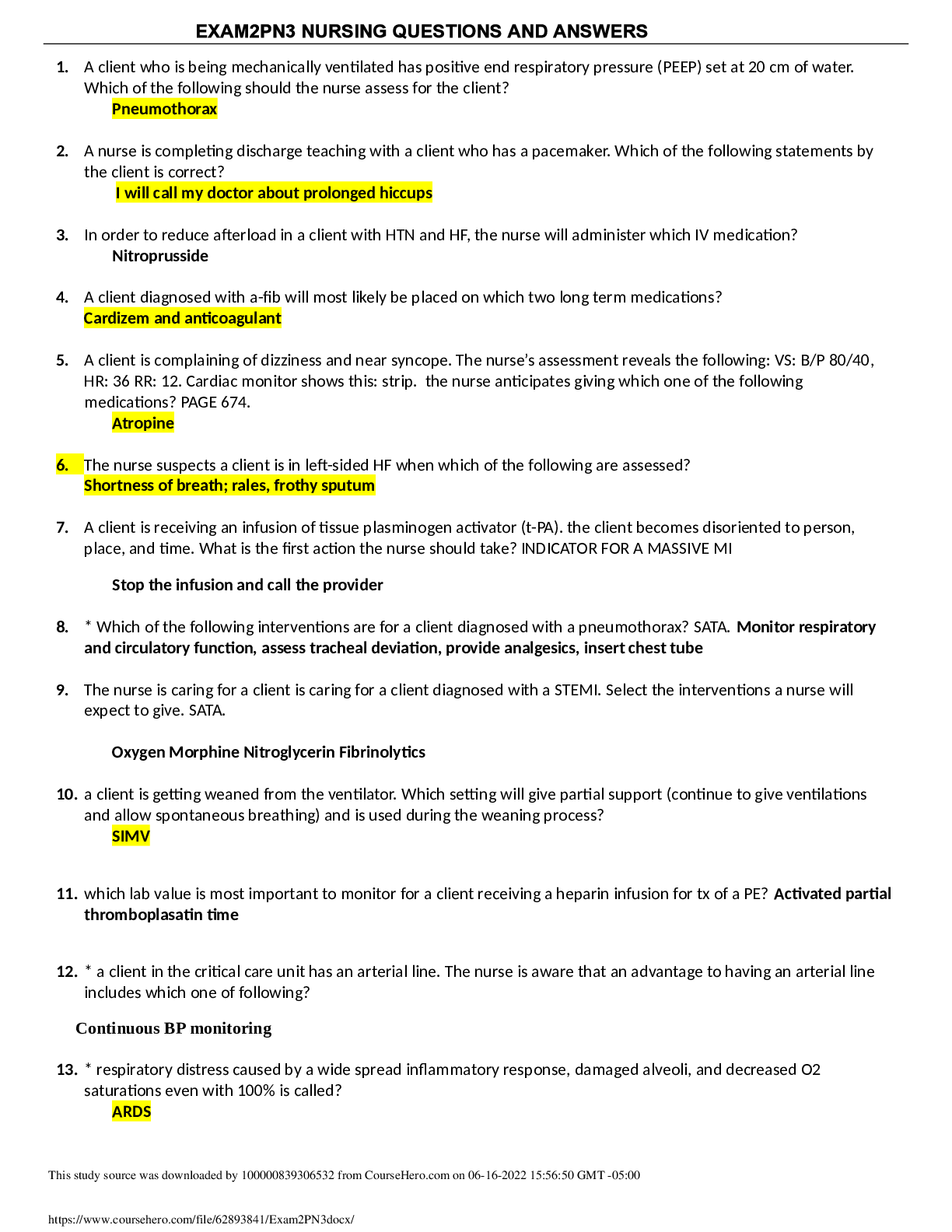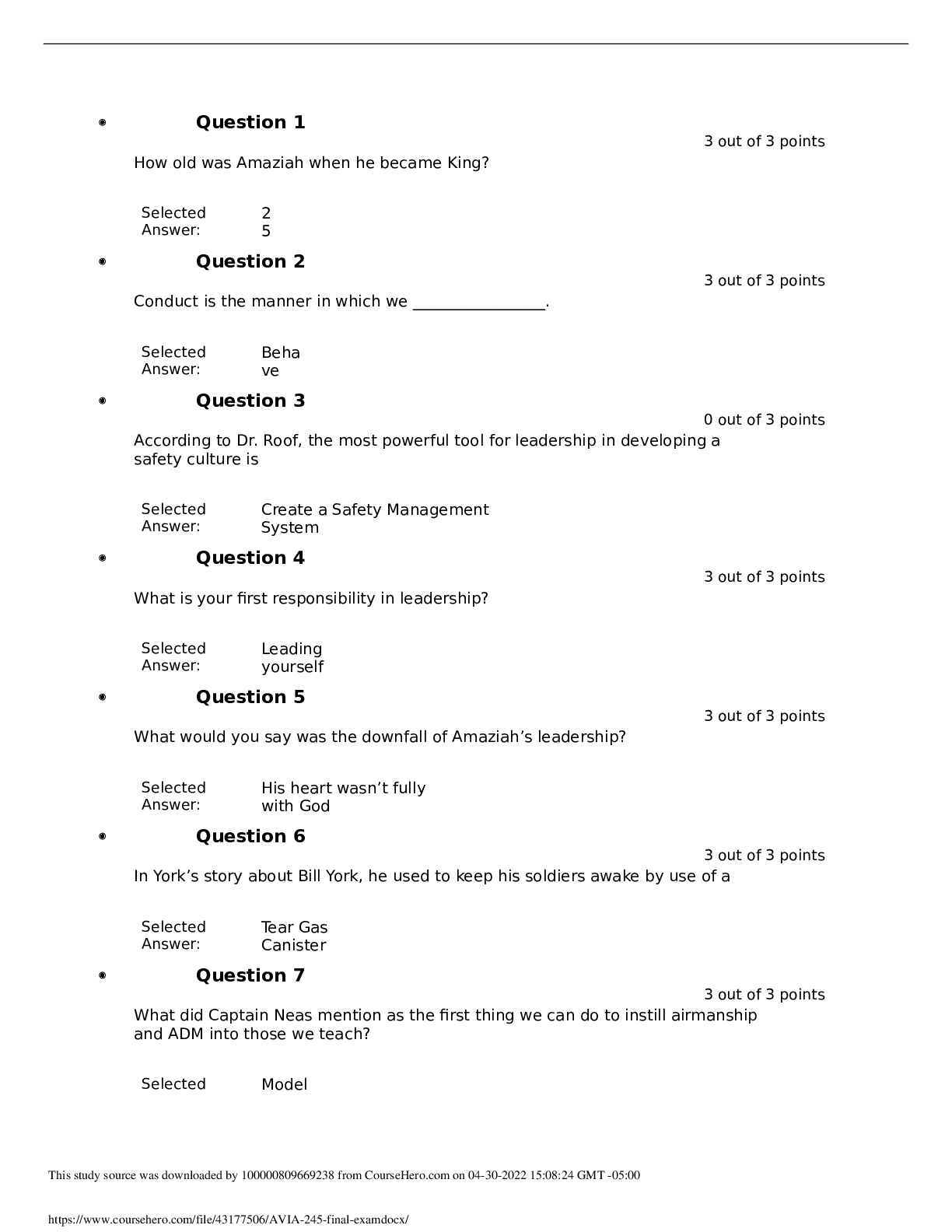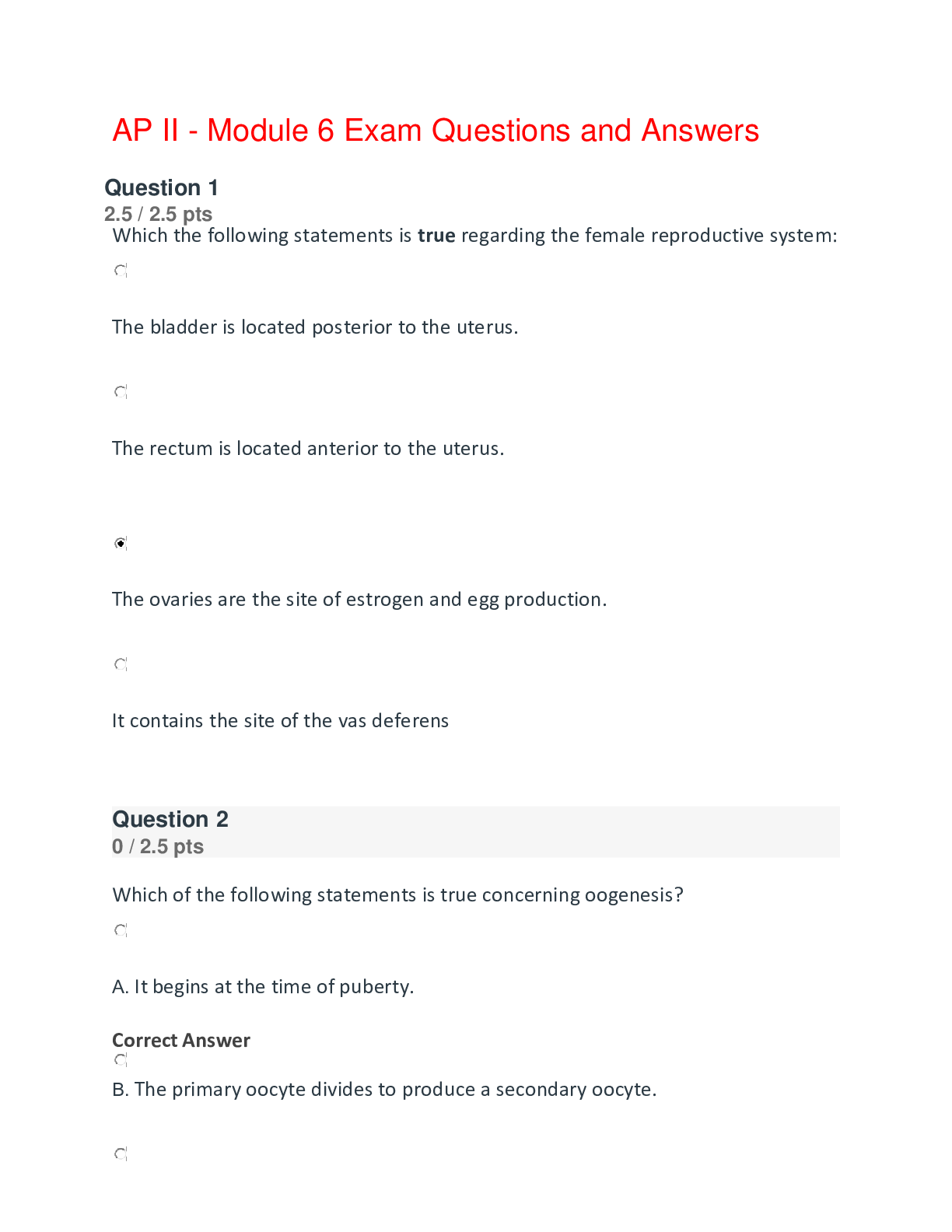NUR 2488 - Module 6 Ch 15-24 Questions and Answers, 100% Correct
Document Content and Description Below
Module 6 Ch 15-24 Chapter 15 Review Anxiety and Obsessive-Compulsive Disorders Questions 1. The nurse is providing care for a patient demonstrating behaviors associated with moderate levels of anxi... ety. What question should the nurse ask initially when attempting to help the patient deescalate their anxiety? 2. Which patient has an increased risk for the development of anxiety and will require frequent assessment by the nurse? Select all that apply. 3. Which medication should the nurse be prepared to educate patients on when they are prescribed a selective serotonin reuptake inhibitor (SSRI) for panic attacks? 4. Which statement(s) made by the nurse demonstrates an understanding of the effective use of relaxation therapy for anxiety management? Select all that apply. 5. To maximize the therapeutic effect, which lifestyle practice should the nurse discourage for a patient who has been recently prescribed an antianxiety medication? 6. In a parent teacher conference, the school nurse meets with the parents of a profoundly shy 8-year-old girl. The parents hold hands, speak softly, respond briefly, and have poor eye contact. The nurse recognizes that the child is most likely exposed to parental modeling and: 7. Isabel is a straight-A student, yet she suffers from severe test anxiety and seeks medical attention. The nurse interviews Isabel and develops a plan of care. The nurse recognizes effective teaching about mild anxiety when Isabel states: 8. The activity of gamma-aminobutyric acid (GABA) contributes to a slowing of neural activity. Which of the following drugs facilitates the action of GABA? 9. Samantha is a new patient to the mental health clinic and is seeking assistance for what she describes as “severe anxiety.” In addition to daily self-medicating with alcohol, Samantha describes long-term use of herbal kava. The nurse knows that kava is associated with inhibiting P450 and orders which of the following tests? 10. A homebound patient diagnosed with agoraphobia has been receiving therapy in the home. The nurse evaluates patient teaching is effective when the patient states: Chapter 16 Review Trauma, Stressor-Related, and Dissociative Disorders Questions 1. Which statement made by the patient demonstrates an understanding of the treatment of choice for patients managing the effects of traumatic events? 2. Which goal should be addressed initially when providing care for 10-year-old Harper who is diagnosed with posttraumatic stress disorder (PTSD)? 3. The care plan of a male patient diagnosed with a dissociative disorder includes the nursing diagnosis ineffective coping. Which behavior demonstrated by the patient supports this nursing diagnosis? 4. Which statement accurately describes the effects of emotional trauma on the individual physically? 5. The school nurse has been alerted to the fact that an 8-year-old boy routinely playacts as a police officer “locking up” other children on the playground to the point where the children get scared. The nurse recognizes that this behavior is most likely an indication of: 6. A pregnant woman is in a relationship with a male who routinely abuses her. Her unborn child may engage in high-risk behavior as a teen as a result of: 7. Maggie, a child in protective custody, is found to have an imaginary friend, Holly. Her foster family shares this information with the nurse. The nurse teaches the family members about children who have suffered trauma and knows her teaching was effective when the foster mother states: 8. An incest survivor undergoing treatment at the mental health clinic is relieved when she learns that her anxiety and depression are: 9. During a routine health screening, a grieving widow whose husband died 15 months ago reports emptiness, a loss of self, difficulty thinking of the future, and anger at her dead husband. The nurse suggests bereavement counseling. The widow is most likely suffering from: 10. A young child is found wandering alone at a mall. A male store employee approaches and asks where her parents are. She responds, “I don’t know. Maybe you will take me home with you?” This sort of response in children may be due to: Chapter 17 Review Somatic Symptom Disorders Questions 1. The care plan of a patient diagnosed with a somatic disorder includes the nursing diagnosis ineffective coping. Which patient behavior demonstrates a successful outcome for that nursing diagnosis? 2. Which patient is at greatest risk for developing a stress- induced myocardial infarction? 3. What precipitating emotional factor has been associated with an increased incidence of cancers? Select all that apply. 4. You are caring for Aaron, a 38-year-old patient diagnosed with somatic symptom disorder. When interacting with you, Aaron continues to focus on his severe headaches. In planning care for Aaron, which of the following interventions would be appropriate? 5. Living comfortable and materialistic lives in Western societies seems to have altered the original hierarchy proposed by Maslow in that: 6. Diane, a 63-year-old mother of three, was brought to the community psychiatric clinic. Diane and her son had a bitter fight over finances. Ever since Diane has been complaining of “a severe pain in my neck.” She has seen several doctors who cannot find a physical basis for the pain. The nurse knows that: 7. Conversion disorder is described as an absence of a neurological diagnosis that manifests in neurological symptoms. Channeling of emotions, conflicts, and stressors into physical symptoms is thought to be the cause in conversion disorder. Which statement is true? 8. Melanie is a 38-year-old female admitted to the hospital to rule out a neurological disorder. The testing was negative, yet she is reluctant to be discharged. Today she has added lower back pain and a stabbing sensation in her abdomen. The nurse suspects a factitious disorder in which Melanie may: 9. You are caring for Yolanda, a 67-year-old patient who has been receiving hemodialysis for 3 months. Yolanda reports that she feels angry whenever it is time for her dialysis treatment. You attribute this to: 10. Lucas is a nurse on a medical floor caring for Kelly, a 48-year-old patient with newly diagnosed type 2 diabetes. He realizes that depression is a complicating factor in the patient’s adjustment to her new diagnosis. What problem has the most potential to arise? Chapter 18 Review Eating and Feeding Disorders Questions 1. Which patient statement acknowledges the characteristic behavior associated with a diagnosis of pica? 2. When considering an eating disorder, what is a physical criterion for hospital admission? 3. When considering the need for monitoring, which intervention should the nurse implement for a patient with anorexia nervosa? Select all that apply. 4. Which intervention will promote independence in a patient being treated for bulimia nervosa? 5. Which patient statement supports the diagnosis of anorexia nervosa? 6. Obesity can be the end result of a binge-eating disorder. The nurse understands that the best treatment option in persons with a binge-eating disorder promotes: 7. Taylor, a psychiatric registered nurse, orients Regina, a patient with anorexia nervosa, to the room where she will be assigned during her stay. After getting Regina settled, the nurse informs Regina: 8. Safety measures are of concern in eating-disorder treatments. Patients with anorexia nervosa are supervised closely to monitor: Select all that apply. 9. Malika has been overweight all of her life. Now an adult, she has health problems related to her excessive weight. Seeking weight loss assistance at a primary care facility Malika is surprised when the nurse practitioner suggests: 10. Malika agrees to try losing weight according to the nurse practitioner’s outlined plan. Additional teaching is warranted when Malika states: Chapter 19 Review Sleep-Wake Disorders Questions 1. Which patient statement supports a diagnosis of narcolepsy? 2. Madelyn, a 29-year-old patient recently diagnosed with depression, comes to the mental health clinic complaining of continued difficulty sleeping. One week ago she was started on a selective serotonin reuptake inhibitor (SRRI), fluoxetine (Prozac), for her depressive symptoms. When educating Madelyn your response is guided by the knowledge that: 3. Which behaviors will the nurse encourage a patient diagnosed with insomnia disorder to adopt? Select all that apply. 4. Which treatment is typically prescribed for primary insomnia? Select all that apply. 5. Light projected into the retina is believed to trigger changes in sleep patterns and quality of sleep. Therefore the nurse should suggest: 6. Sleep disturbances are often overlooked or undiagnosed due to: 7. Many people allow life circumstances to dictate their amount of sleep instead of recognizing sleep as a priority. Which statement will the nurse recognize as progress in the patient’s sleep hygiene program? 8. Larry is a 50-year-old man who works about 60 hours per week. He arrives at the clinic seeking assistance with a weight gain of 50 pounds over the past year. Larry admits to sleeping 4 to 5 hours a night. The nurse recognizes that the weight gain may be related to: 9. Sleep deprivation is considered a safety issue that results in loss of life and property. Psychomotor impairments of sleep deprivation are similar to symptoms caused by: 10. The stage of sleep known as rapid eye movement or REM sleep is characterized by atonia and myoclonic twitches in addition to the actual rapid movement of the eyes. Atonia is thought to be a protective mechanism as it: Chapter 20 Review Sexual Dysfunction, Gender Dysphoria, and Paraphilias Questions 1. Which patient statement suggests a concern over one’s ability to perform sexually? 2. The nurse should plan to educate the male patients prescribed a statin medication on the possible development of which commonly observed side effect? 3. Which medications are currently approved for the treatment of male erectile disorder? Select all that apply. 4. Which statement describes a common sexual side effect of diazepam (Valium)? 5. Obtaining a sexual history can be embarrassing for the patient and practitioner. Experience with addressing the topic can help, as well as: 6. Which patient has the greatest risk for suicide? 7. When Melissa was a small child, she insisted that she was a boy, refused to wear dresses, and wanted to be called Mitch. As Melissa reached puberty, she no longer displayed a desire to be male. This change in identity is considered: 8. Phillip, a 63-year-old male, has exposed his genitals in public for all of his adult life, but the act has lost some of the former thrill. A rationale for this change in his experience may be: 9. A male arrested for inappropriate sexual contact in a subway car denies the allegation. Upon interviewing the man, the nurse suspects frotteuristic disorder due to his: 10. Pedophilic disorder is the most common paraphilic disorder where adults who have a primary or exclusive sexual preference for prepubescent children. A subset of this disorder is termed hebephilia and is defined as attraction to: Chapter 21 Review Impulse Control Disorders Questions 1. Which statement made by a 9-year-old child after hitting a classmate is a typical comment associated with childhood conduct disorder? 2. What assessment data would support a diagnosis of conduct disorder? Select all that apply. 3. Which event experienced in the patient’s childhood increases the risk of the development of behaviors associated with intermittent explosive disorder? 4. What is a common behavior observed in a patient diagnosed with intermittent explosive disorder? Select all that apply. 5. When discussing oppositional defiant disorder with a group of parents, what information should the nurse include about the disorder? Select all that apply 6. Tommy, a 12-year-old boy admitted to the pediatric psychiatric unit, has recently been diagnosed with conduct disorder. In the activity room, the games he wanted to play were already in use. He responded by threatening to throw furniture and to hurt his peers who had the game he wanted. Nancy, a registered nurse, recognizes that Tommy’s therapy must include: 7. Some cultures have lower rates of diagnosed conduct disorders than observed in Western societies. The lower rate of incidence may be contributed to: 8. Larry, a middle-aged male in a treatment facility, is loudly displaying anger in the day room with a visiting family member. It is obvious to the nurse this pattern has played out before. Violence is often escalated when family members or authority figures: 9. The impulse control spectrum can begin in childhood and continue on into adulthood, often morphing into criminal behaviors. Working with patients diagnosed with these disorders, the best examples of expressed emotion by the nursing staff are: 10. Claude is a new nurse on the psychiatric unit. He asks a senior nurse on staff for the “best advice” when working with oppositional defiant disorder. Which statement reflects advice on solid therapeutic communication? Chapter 22 Review Substance-Related and Addictive Disorders Questions 1. A patient with a history of alcohol use disorder has been prescribed disulfiram (Antabuse). Which physical effects support the suspicion that the patient has relapsed? Select all that apply. 2. Which assessment data confirm the suspicion that a patient is experiencing opioid withdrawal? Select all that apply. 3. The nursing diagnosis ineffective denial is especially useful when working with substance use disorders and gambling. Which statements describe this diagnosis? Select all that apply. 4. What action should you take when a female staff member is demonstrating behaviors associated with a substance use disorder? 5. A patient diagnosed with opioid use disorder has expressed a desire to enter into a rehabilitation program. What initial nursing intervention during the early days after admission will help ensure the patient’s success? 6. Lester and Eileen have always enjoyed gambling. Lately, Eileen has discovered that their savings account is down by $50,000. Eileen insists that Lester undergo therapy for his gambling behavior. The nurse recognizes that Lester is making progress when he states: 7. Opioid use disorder is characterized by: 8. Terry is a young male in a chemical dependency program. Recently he has become increasingly distracted and disengaged. The nurse concludes that Terry is: 9. Maxwell is a 30-year-old male who arrives at the emergency department stating, “I feel like I am having a stroke.” During the intake assessment, the nurse discovers that Maxwell has been working for 36 hours straight without eating and has consumed eight double espresso drinks and 12 caffeinated sodas. The nurse suspects: 10. Donald, a 49-year-old male, is admitted for inpatient alcohol detoxification. He is cachexic, has multiple scabs on his arms and legs, and has lower extremity edema. An appropriate nursing diagnosis for Donald along with an expected outcome is: Chapter 23 Review Neurocognitive Disorders Questions 1. Which statement made by the primary caregiver of a patient diagnosed with dementia demonstrates accurate understanding of providing the patient with a safe environment? 2. Which statement made by a family member tends to support a diagnosis of delirium rather than dementia? 3. When considering the pathophysiology responsible for both delirium and dementia, which intervention is appropriate for delirium specifically? 4. What side effects should the nurse monitor for when caring for a patient prescribed donepezil (Aricept)? Select all that apply. 5. What is the rationale for providing a patient diagnosed with dementia easily accessible finger foods thorough the day? 6. Ophelia, a 69-year-old retired nurse, attends a reunion of her former coworkers. Ophelia is concerned because she usually knows everyone, and she cannot recognize faces today. A registered nurse colleague recognizes Ophelia’s distress and “introduces” Ophelia to those attending. The nurse practitioner recognizes that Ophelia seems to have a deficit in: 7. Nancy is a nurse. After talking with her mother, she became concerned enough to drive over and check on her. Her mother’s appearance is disheveled, words are nonsensical, smells strongly of urine, and there is a stain on her dressing gown. Nancy recognizes that her mother’s condition is likely temporary due to: 8. Darnell is an 84-year-old widower who has lived alone since his wife died 6 years ago. A neighbor called Darnell’s son to tell him that Darnell was trying to start his car from the passenger’s side. He became angry and aggressive when the car would not start. After a medical assessment, Darnell was diagnosed with a major neurocognitive disorder. The nurse realized additional family teaching is necessary when Darnell’s son states: 9. In the 2 months after his wife’s death, Aaron, aged 90 and in good health, has begun to pay less attention to his hygiene and seems less alert to his surroundings. He complains of difficulty concentrating and sleeping and reports that he lacks energy. His family sometimes has to remind and encourage him to shower, take his medications, and eat, all of which he then does. Which response is most appropriate? 10. Nurses caring for patients who have neurocognitive disorders are exposed to stress on many levels. Specialized skills training and continuing education are helpful to diffuse nursing stress, as well as: Select all that apply. Chapter 24 Review Personality Disorders Questions 1. Which statement made by the psychiatric nurse demonstrates an accurate understanding of the factors that affect an individual’s personality? 2. When assessing a patient diagnosed with a borderline personality disorder, which statement by the patient warrants immediate attention? 3. What is the current accepted professional view of the effect of culture on the development of a personality disorder? 4. Which personality disorders are generally associated with behaviors described as “odd or eccentric”? Select all that apply. 5. Which behaviors are examples of a primitive defense mechanism often relied upon by those diagnosed with a personality disorder? Select all that apply. 6. Personality disorders often co-occur with mood and eating disorders. A young woman is undergoing treatment at an eating disorders clinic and her nurse suspects the patient may also have a Cluster B personality disorder due to the young woman’s: 7. Larry is from a small town and began displaying aggressive and manipulative traits while still a teenager. Now at 40 years old, Larry is serving a life sentence for the murders of his wife and her brother. John, the prison psychiatric nurse practitioner, recognizes that Larry’s treatment will most likely: 8. Connor is a 28-year-old student, referred by his university for a psychiatric evaluation. He reports that he has no friends at the university and people call him a loner. Recently, Connor has been giving lectures to pigeons at the university fountains. Connor is diagnosed as schizotypal, which differs from schizophrenia in that persons diagnosed as schizotypal: 9. Garret’s wife of 8 years is divorcing him because the marriage never developed a warm or loving atmosphere. Garrett states in therapy, “I have always been a loner,” and was never concerned about what others think. The nurse practitioner suggests that Garrett try a trial of bupropion (Wellbutrin) to: 10. Josie, a 27-year-old patient, complains that most of the staff do not like her. She says she can tell that you are a caring person. Josie is unsure of what she wants to do with her life and her “mixed-up feelings” about relationships. When you tell her that you will be on vacation next week, she becomes very angry. Two hours later, she is found using a curling iron to burn her underarms and explains that it “makes the numbness stop.” Given this presentation, which personality disorder would you suspect? [Show More]
Last updated: 1 year ago
Preview 1 out of 16 pages
Instant download

Buy this document to get the full access instantly
Instant Download Access after purchase
Add to cartInstant download
Reviews( 0 )
Document information
Connected school, study & course
About the document
Uploaded On
Jan 25, 2021
Number of pages
16
Written in
Additional information
This document has been written for:
Uploaded
Jan 25, 2021
Downloads
0
Views
54


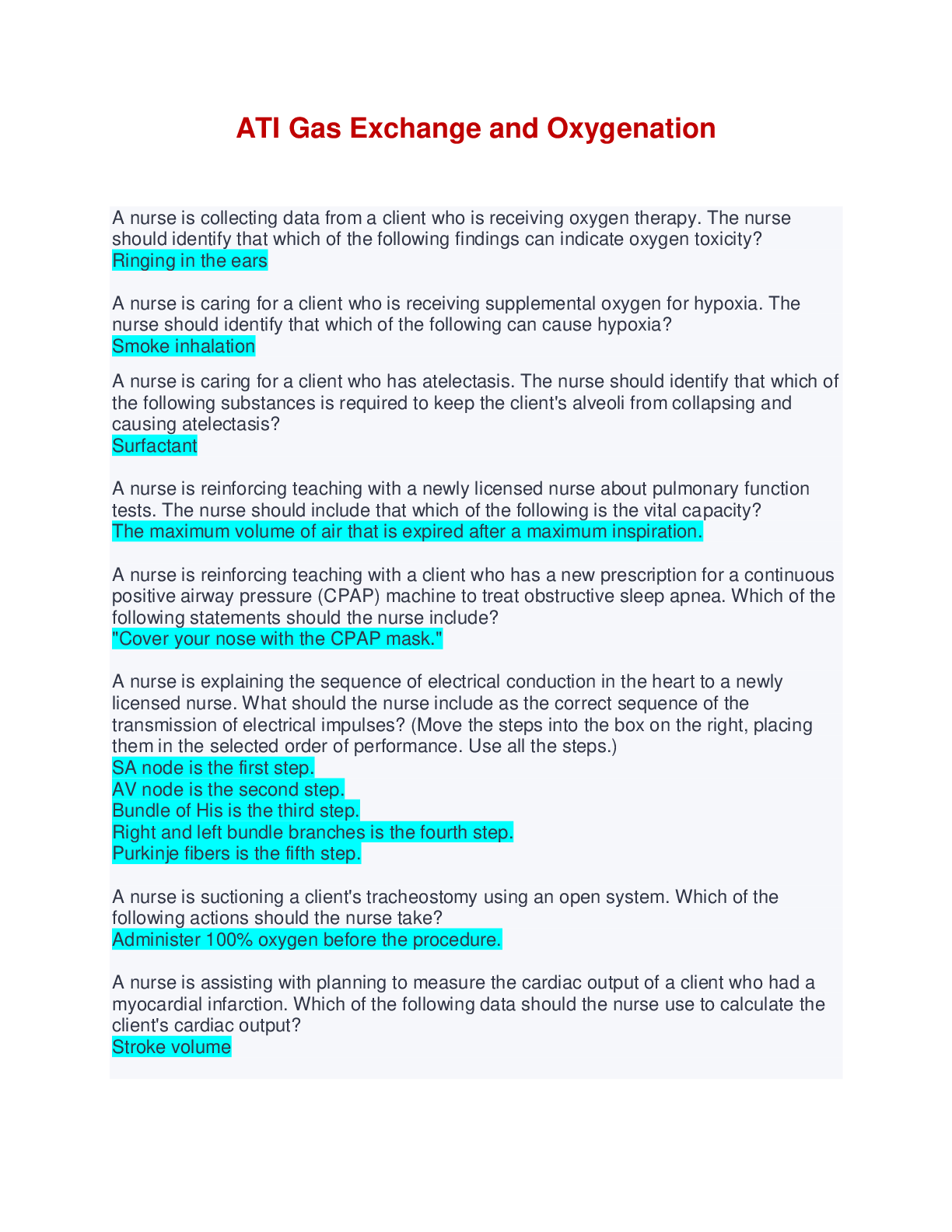






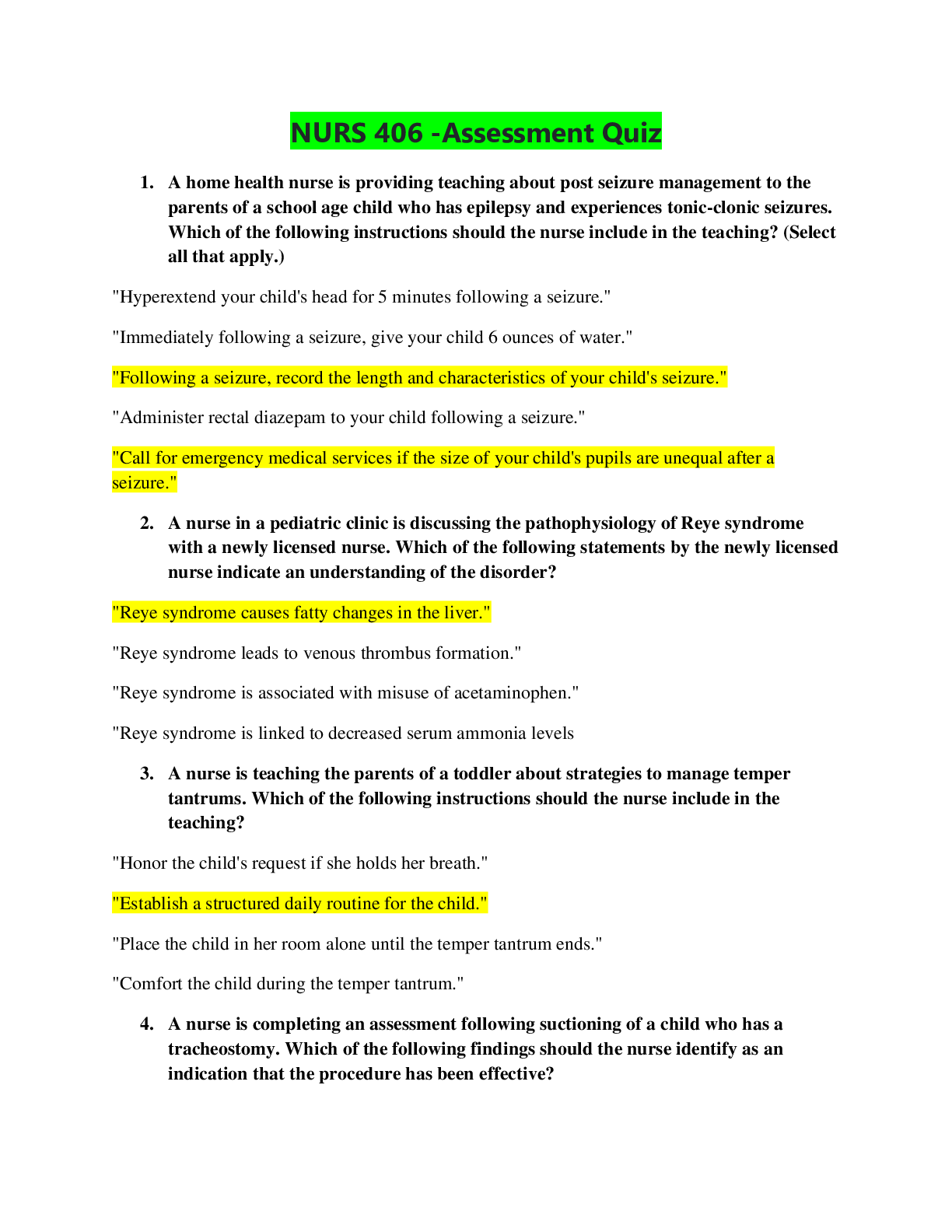



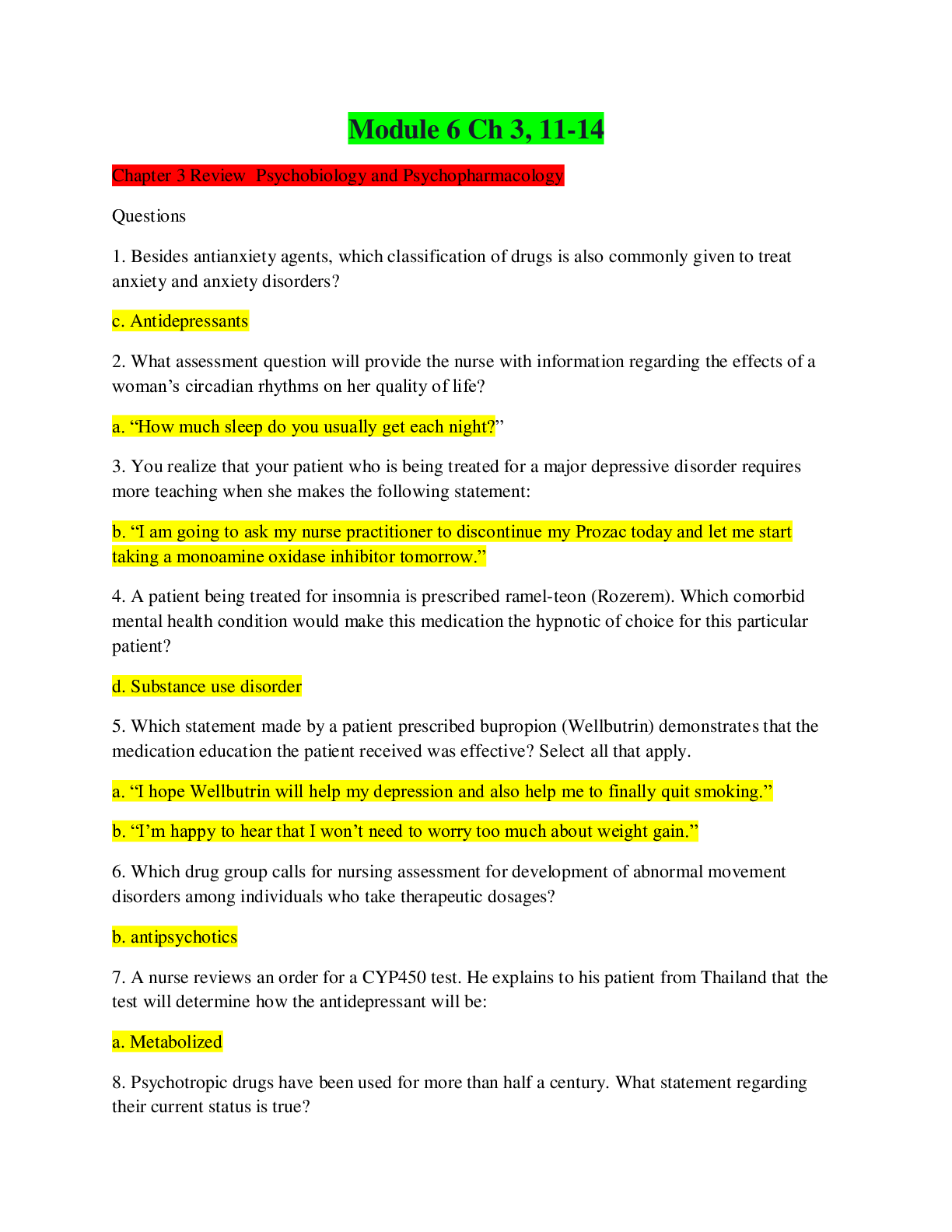
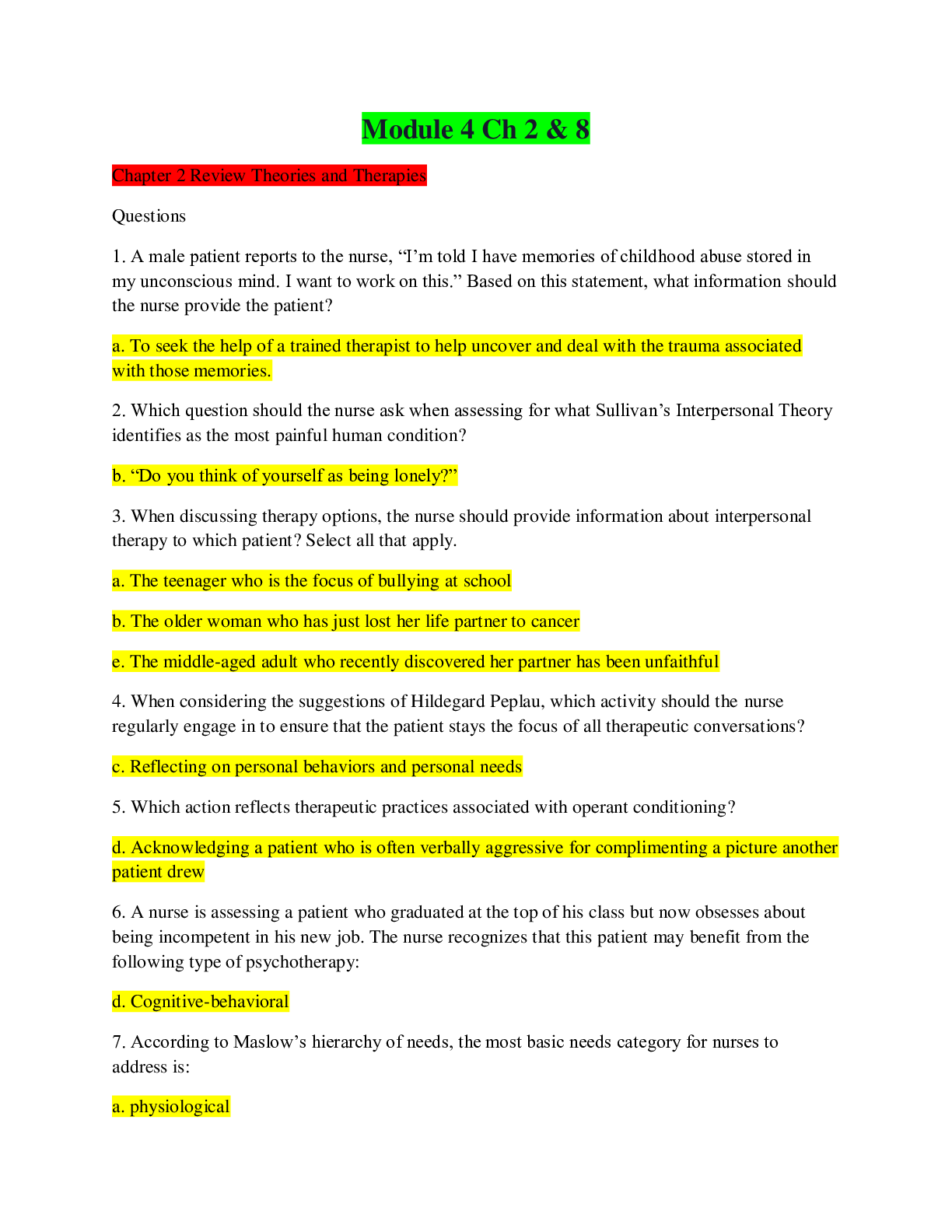
 M21.png)
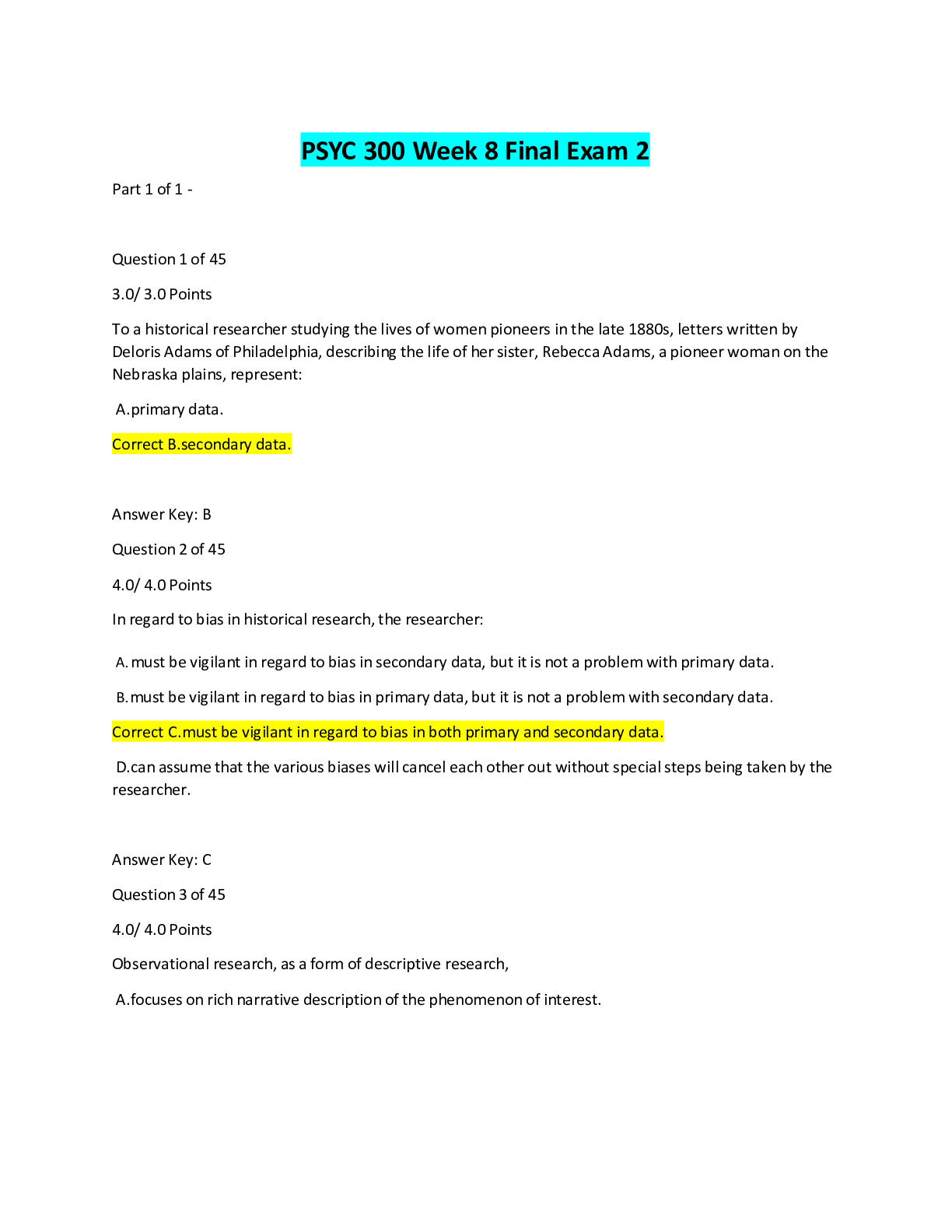
 (1).png)
.png)
